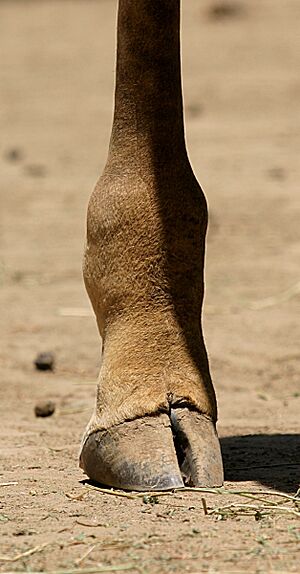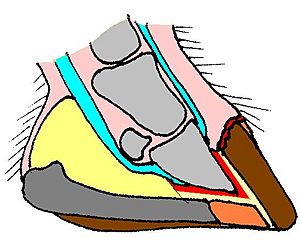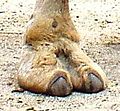Hoof facts for kids
A hoof is the strong, hard foot of certain animals. These animals are called ungulates. Think of animals like deer, cows, pigs, sheep, and giraffes. Ungulates walk on their toes, and their toes are covered by a very tough material. This material is similar to your fingernails and is called keratin. It helps protect their feet.
What is a Hoof?
A hoof covers the end part of an animal's leg, protecting important bones and soft tissues inside. It includes the hoof wall, the sole, and a special part called the frog.
Hooves do many important jobs for animals. They help support the animal's weight. They also absorb the shock when the animal's foot hits the ground. Hooves protect the bones and tissues inside the foot. Plus, they give the animal grip, helping it walk or run without slipping. Many things can affect how healthy a hoof is, like an animal's genes, how its hoof is shaped, its environment, and how much it exercises.
Different Kinds of Hooves
Most animals with hooves have what is called a cloven hoof. This means their hoof is split into two main parts. Animals like sheep, goats, deer, cattle, bison, and pigs have cloven hooves.
Many of these animals also have two smaller hooves higher up on their leg. These are called dewclaws. Usually, dewclaws don't touch the ground when the animal walks. But for some animals, like deer and pigs, dewclaws might touch the ground when they run or jump. They can also help if the ground is soft. Mountain goats use their dewclaws for extra grip when climbing down rocky hills or on slippery surfaces like ice or snow. Other animals, like giraffes and pronghorns, do not have dewclaws.
Some animals, like camels, have feet that look like hooves but are different. Their "hooves" are not hard. Instead, they have soft toes with a small nail that just looks like a hoof.
Other animals, called "odd-toed ungulates," have a different number of toes. For example, horses have one hoof on each foot. The tapir is special because it has three toes on each back foot and four toes on each front foot.
Caring for Hooves
Hooves grow all the time, just like your fingernails. In the wild, animals naturally wear down their hooves as they walk and run. But for farm animals or pets, like horses and cows, their hooves often need special care. This care helps keep their hooves healthy and working well.
If hooves are not worn down naturally, they might need to be trimmed. A person who trims hooves is called a farrier. Proper hoof trimming is very important to prevent animals from becoming lame or having trouble walking. For horses, people often say, "no foot, no horse." This means that healthy hooves are extremely important for a healthy horse.
Hoof care is very well known in the equine industry (which is about horses). If a horse's hooves are not cared for properly, problems can happen. These include hoof cracks, infections like thrush, painful abscesses, and a serious condition called laminitis.
Images for kids
-
Rear foot of a giraffe (no dewclaws)
-
Rear hooves of a horse
-
Camel hoof
-
Malayan tapir hooves: front with four toes, back with three toes
-
Cloven hooves of roe deer (Capreolus capreolus), with clear dewclaws
-
Trimming the hoof of a cow with an angle grinder
See also
 In Spanish: Pezuña para niños
In Spanish: Pezuña para niños









